Analyzing the evolution of Korean furniture shapes during the Joseon dynasty is no easy task, given the lack of documentation and pieces available today.
However, the study of a large number of photos from various Korean museums allows us to make the following observations:
In Asia, in general, and unlike European furniture, emperors did not impose new styles.
In France, furniture design differed greatly from one period to another. For example, Louis XIV, Louis XV, Louis XVIII furniture had their own character.
In China, we talk about “Ming” style, “Qing” style, each period covering around four centuries.
In Korea, the task is even more complex, given the history of this small, sparsely populated country.
We’ve discussed the absence of furniture dating back to the first centuries of the Joseon dynasty. The earliest pieces, though scarce, are primarily housed in the collections of Korean museums. Their analysis has enabled us to trace a certain evolution in decorative styles and motifs during the latter part of the Joseon dynasty.
We examine various types of furniture, including bandaji, jangs (clothing chests), and bookchests or document chests.
Regarding the bandaji, the design remains largely fixed according to the era. The general appearance, dimensions, decorative motifs, and leg types presented in our publication: KOREAN BANDAJI – 반닫이 have always been faithfully reproduced, with no major modifications made.
The “Morijang” presents a special case. Indeed, the earliest available models seem to have been associated with the furnishings of the nobility.
With the exception of mother-of-pearl boxes dating from the Goryo dynasty (918 – 1392) and the early Joseon dynasty, let’s focus on the evolution of furniture that was more likely to be owned by a larger number of people. The first type of furniture presented here concerns the book chest or document storage cabinet. Although limited in number as they were reserved for the elite class, these pieces of furniture, most of which date from the 18th and 19th centuries, illustrate the tastes of Korean notables during this period. Dark in color, these rustic pieces featured minimal decorative hinges.
DOCUMENT & BOOK CHESTS.
The furniture containing books and documents was few in number, being reserved exclusively for scholars, who represented a small portion of the population. Most of them date from the 19th century at the latest and seem to have gradually disappeared in the 20th century. In the 20th century, most of these cabinets were for reproductions intended for export and decoration. Today, original pieces are scarce.

Collection: National Folk Museum, Seoul.

Collection: National Folk Museum, Seoul.

H. 59,8cm, W. 76,5cm, D. 32,5cm.
Collection: National Folk Museum, Seoul.

H. 93,6cm, W. 92,5cm, D. 34cm.
Collection: National Folk Museum, Seoul.

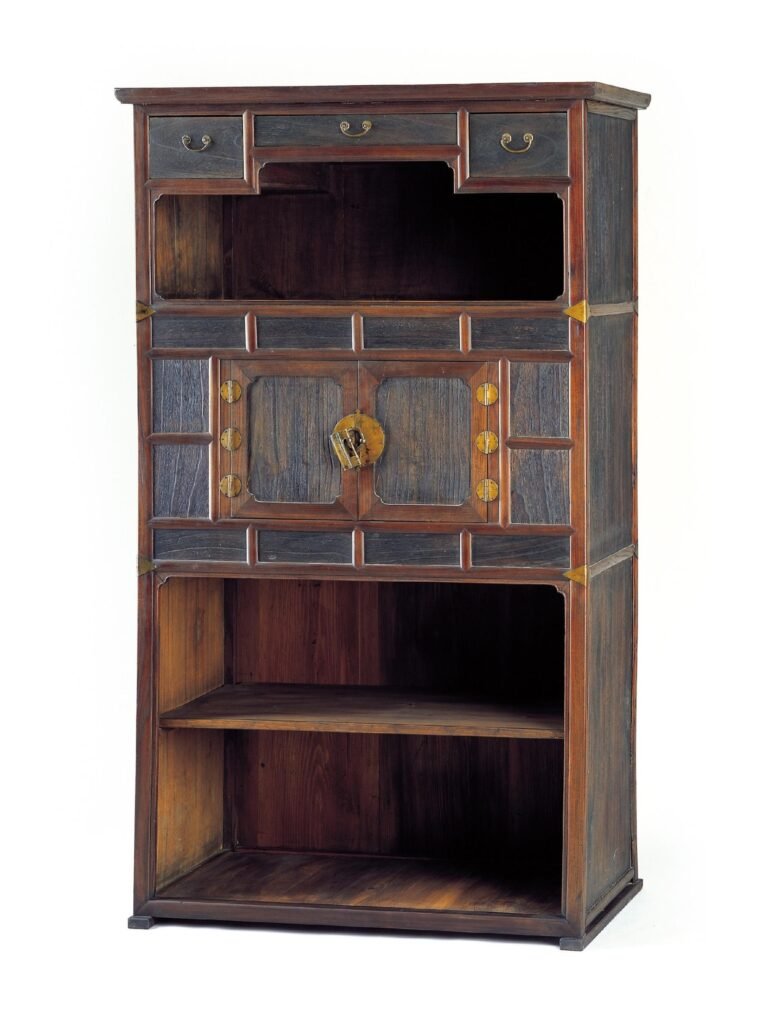
Collection: National Folk Museum, Seoul.
MORIJANG.
For a complete description of the Morijang check: MORIJANG 머릿장
The earliest pieces (19th century and earlier) appear to have been simple boxes with drawers at the top and double doors in the middle. They were often small, averaging H. 40-45cm, W. 80cm, D. 35cm. These pieces were typically dark in color and lacked excessive decoration, reflecting the predominant Confucian philosophy of the period. They were supported by simple, designed legs.

Most of them must have belonged to the noble class of society. Two details suggest this: the use of yellow brass for the hinges, which was an expensive material at the time, and the raised edges of the top plate, a common feature in scholarly furniture.

Collection: National Folk Museum, Seoul.


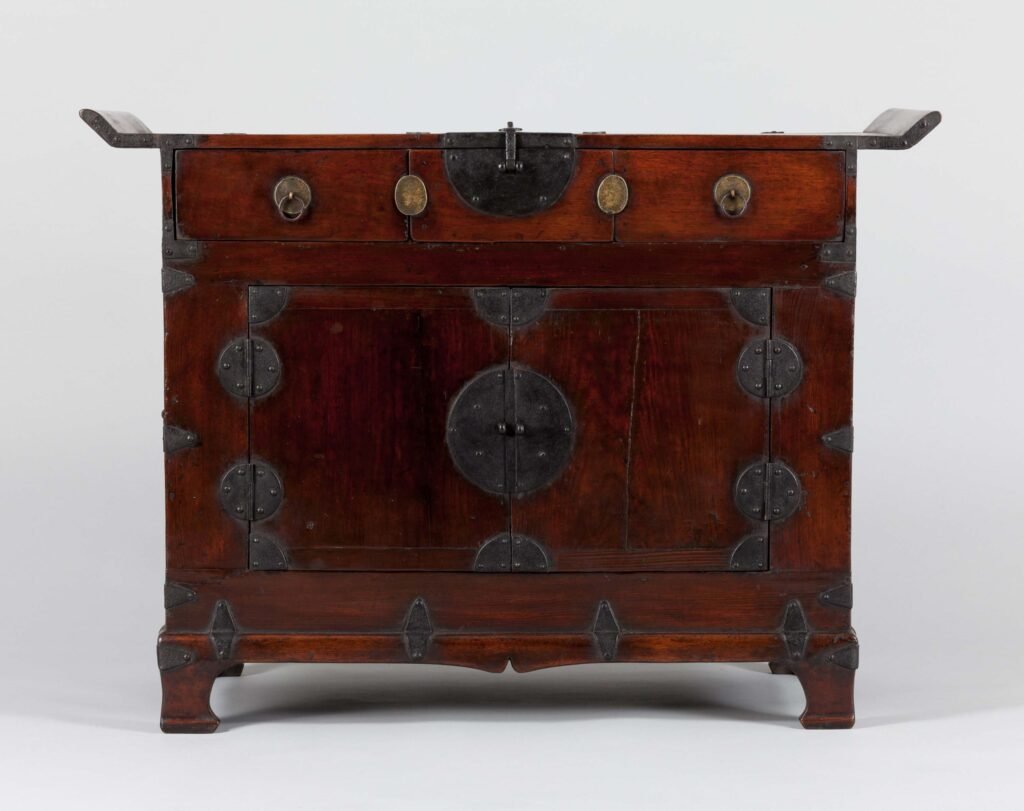

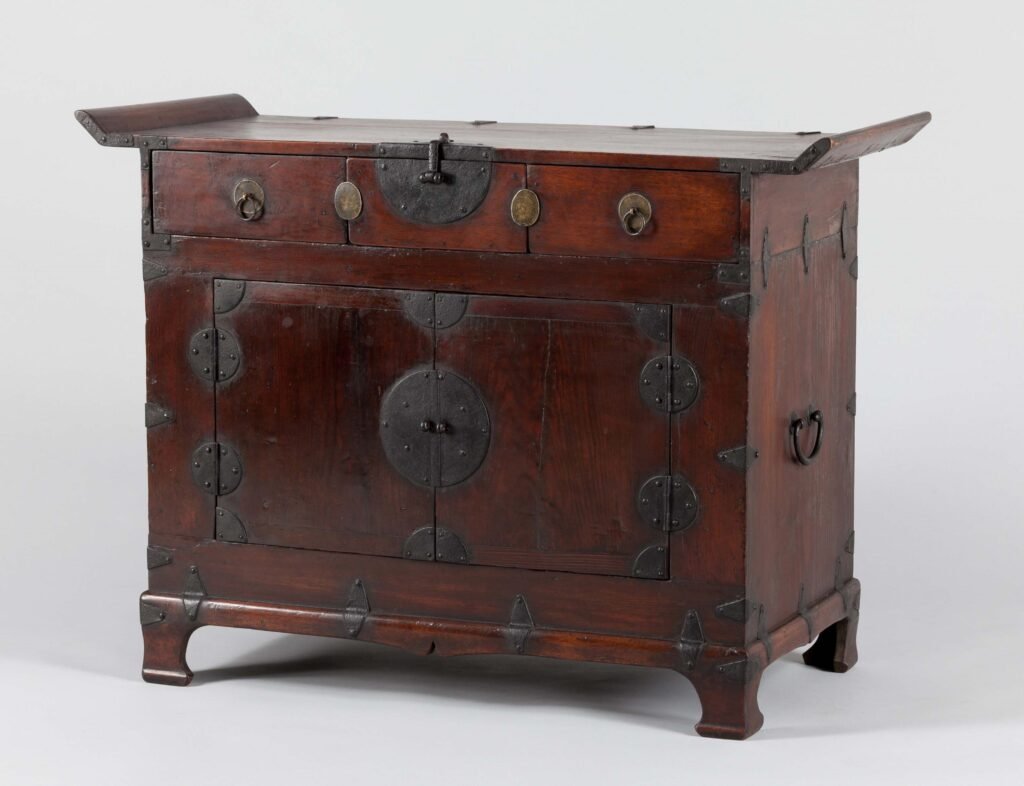

Early to mid 19th century.


Collection: National Folk Museum, Seoul.

Collection: National Folk Museum, Seoul.


H. 46cm, W. 69,5cm, D. 35,5cm.
Collection: National Folk Museum, Seoul.

Their notable change in design seems to date from the early 20th century, following a period of economic development that favored greater production for a larger number of people.
The morijang is becoming a larger piece of furniture ( H. 100cm, W. 100cm, D. 40 – 45cm. ) and its design is becoming more uniform. It still features a row of three to four drawers under the top panel and a double door in the middle. The greater use of metal parts is also for decorative purposes and white brass, a cheaper material, is also used for the fittings. It rests on “cabriole” feet.

Collection: National Folk Museum, Seoul.


Collection: National Folk Museum, Seoul.

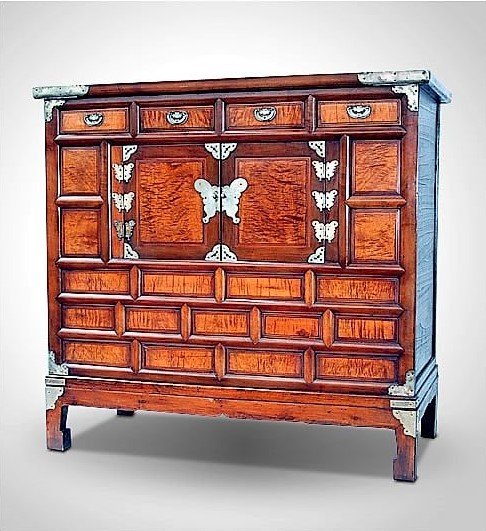
Mid 20th century. H. 102cm, L. 107cm, D. 50cm. Private collection.

CLOTHING CHEST – JANG.
The “Jang” or multi-level garment cabinet also underwent modifications at the end of the Joseon dynasty. These modifications mainly concerned the size of the cabinet, as well as the arrangement and number of hinges.
The oldest pieces are simple, dark, and devoid of excessive decoration. These furnishings were shorter, averaging 1m in height.
Simple iron or gilded brass hinges were only used to hold the furniture in place, rather than for decorative purposes.



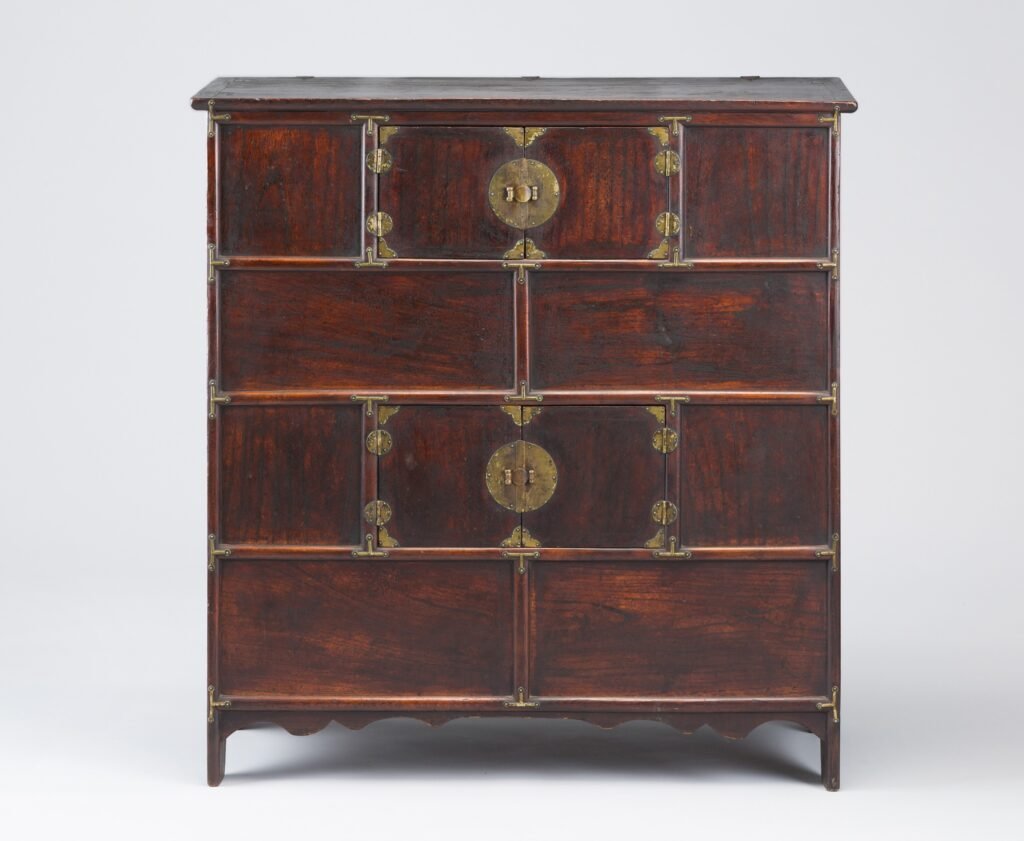
H. 100,5cm, W. 96cm, D. 44cm.
Collection: National Folk Museum, Seoul.


H. 149cm, W. 94,5cm, D. 39cm.
Collection: National Folk Museum, Seoul.



H. 149,8cm, W. 98,9cm, D. 44cm.
Collection: Andong City Folk Museum.

H. 150,4cm, W. 90cm, D. 45,6cm.
Collection: Seoul National University Museum
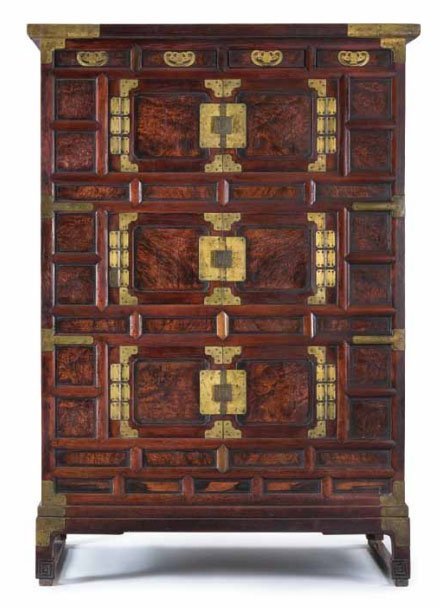
H. 148cm, W. 93cm, D. 45,2cm.
UIGORI JANG.
The “Uigori jang“, a wardrobe designed for hanging clothes, only emerged in the late 19th century. Initially constructed on a single level, it underwent transformations in the early 20th century. Contemporary furniture is typically larger, sometimes separable, and features two levels.
Note also the presence of mirrors on the later pieces’ doors.

H. 177,5cm, W. 91,7cm, D. 56,2cm.
Collection: National Folk Museum, Seoul.


H. 156cm, W. 82cm, D. 41,5cm.
Collection: National Folk Museum, Seoul.
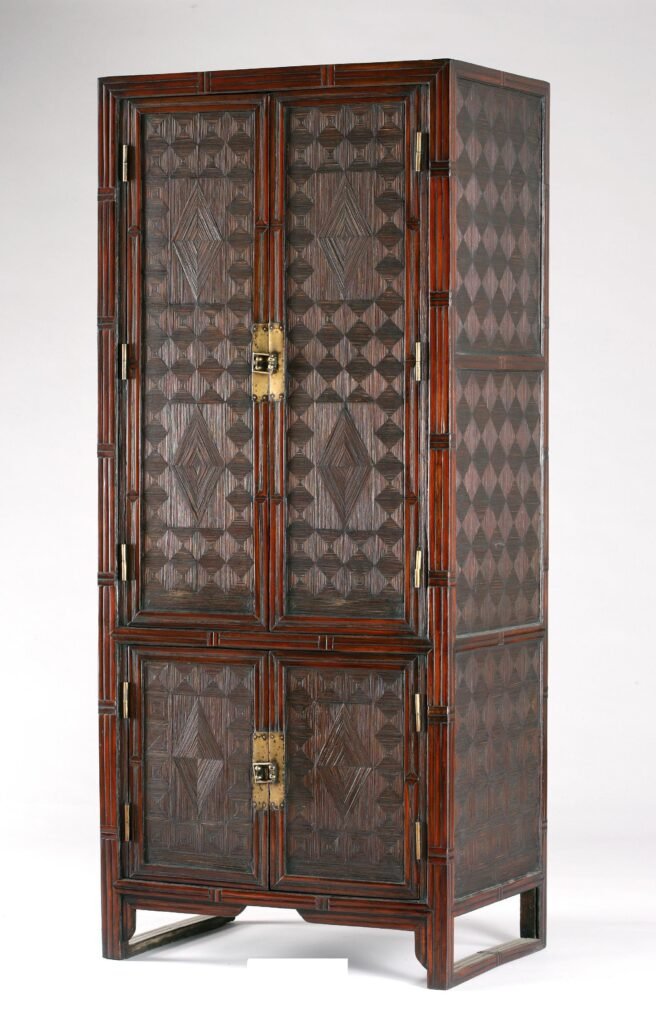
H. 149cm, W. 64,5cm, D. 41,5cm.
Collection: National Folk Museum, Seoul.

Collection: National Folk Museum, Seoul.

H. 168,2cm, W. 93,3cm, D. 50,3cm.
Collection: National Folk Museum, Seoul.

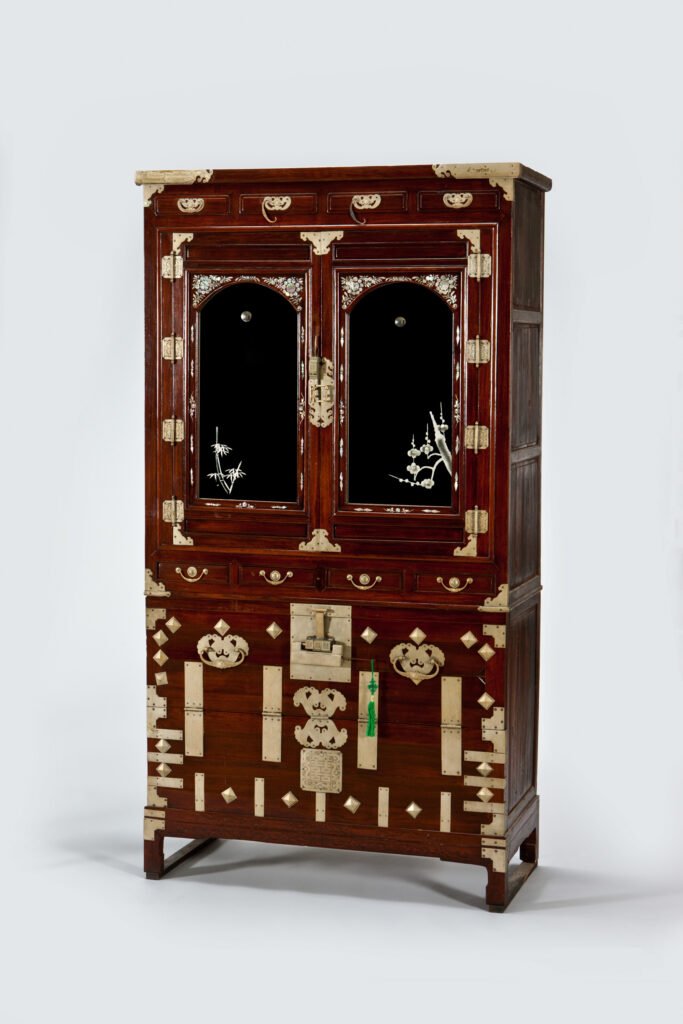
H. 185cm, W. 100cm, D. 45cm.
Collection: Korean national Museum, Seoul.
In conclusion, while rustic, dark-colored, small-scale furniture predominated during the Joseon dynasty, changes in size and decoration occurred at the end of the dynasty. This period extending from the late 19th century to the early 20th century, coincided with the country’s opening up to the outside world and the emergence of new social classes amid economic development.
These indications, I hope, will enable enthusiasts to better identify the pieces encountered.

